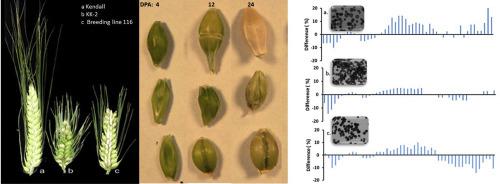Plant Physiology and Biochemistry ( IF 6.1 ) Pub Date : 2020-06-21 , DOI: 10.1016/j.plaphy.2020.05.043 Sarita Jaiswal 1 , Monica Båga 1 , Ravindra N Chibbar 1

|
Brassinosteroids (BR) are plant-based steroids which influence several morphogenetic and developmental processes. A barley (Hordeum vulgare L.) genotype Kinai Kyoshinkai-2 (KK-2) carrying the uzu mutation exhibited altered starch granule size distribution. Hybridizing KK-2 with a barley genotype CDC Kendall with bi-modal starch granules produced progeny lines (116, 144 and 168) with almost uni-modal starch granules. Bioassays correlated uzu mutation with defective BR perception. DNA sequence analysis of the BR receptor-1 (BRI-1) gene detected a single-nucleotide A > G substitution at the position 2612 in the kinase domain which resulted in the change of His (CAC) to Arg (CGC) at residue 857 in subdomain IV of the kinase domain of the respective polypeptide. The study focused on the development of barley grain, accumulation of starch and composition influenced by defective BR perception due to the mutation detected in KK-2 and three other barley-breeding lines (116, 144 and 168). Aberrant BRI-1 delayed grain development, amylose synthesis and starch accumulation in the endosperm. The barley breeding lines 116, 144 and 168 carrying the aberrant BRI-1, exhibited altered granule size distribution with significant shift in the diameter maxima, but insignificant differences in amylose concentration. The BRI-1 mutation also altered amylopectin fine structure in both B- and C- type small starch granules, resulting in an increased fraction of short A-type glucan chains (<10 DP) and decreased fraction of B2 chains (25–36 DP) in genotypes carrying the BRI-1 mutation. The results show the influence of BR on barley grain development, starch accumulation, granule size distribution and amylopectin structure.
中文翻译:

油菜素类固醇受体突变影响大麦籽粒中淀粉颗粒的大小分布。
油菜素类固醇(BR)是植物类固醇,会影响几种形态发生和发育过程。携带uzu突变的大麦(大麦属L.)基因型Kinai Kyoshinkai-2(KK-2)表现出改变的淀粉颗粒尺寸分布。用大麦基因型CDC Kendall与双峰淀粉颗粒杂交KK-2,产生具有几乎单峰淀粉颗粒的后代系(116、144和168)。生物测定相关UZUBR感知缺陷的突变。BR受体1(BRI-1)基因的DNA序列分析检测到激酶结构域中2612位置的单核苷酸A> G取代,这导致残基857处的His(CAC)变为Arg(CGC)在相应多肽的激酶结构域的亚结构域IV中。该研究的重点是大麦籽粒的发育,淀粉的积累和组成的缺陷,这些缺陷是由于在KK-2和其他三个大麦育种系(116、144和168)中检测到的突变而受到BR感知缺陷的影响。异常的BRI-1延迟了胚乳的籽粒发育,直链淀粉合成和淀粉积累。携带异常BRI-1的大麦育种系116、144和168的颗粒大小分布发生了变化,最大直径发生了明显变化,但直链淀粉浓度差异不明显。BRI-1突变还改变了B型和C型小淀粉颗粒中支链淀粉的精细结构,导致短的A型葡聚糖链比例(<10 DP)和B2链比例降低(25-36 DP) )携带BRI-1突变的基因型。结果表明BR对大麦籽粒发育,淀粉积累,颗粒大小分布和支链淀粉结构的影响。











































 京公网安备 11010802027423号
京公网安备 11010802027423号